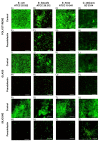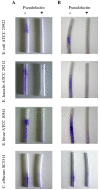Antiadhesive activity of the biosurfactant pseudofactin II secreted by the Arctic bacterium Pseudomonas fluorescens BD5
- PMID: 22360895
- PMCID: PMC3310744
- DOI: 10.1186/1471-2180-12-24
Antiadhesive activity of the biosurfactant pseudofactin II secreted by the Arctic bacterium Pseudomonas fluorescens BD5
Abstract
Background: Pseudofactin II is a recently identified biosurfactant secreted by Pseudomonas fluorescens BD5, the strain obtained from freshwater from the Arctic Archipelago of Svalbard. Pseudofactin II is a novel compound identified as cyclic lipopeptide with a palmitic acid connected to the terminal amino group of eighth amino acid in peptide moiety. The C-terminal carboxylic group of the last amino acid forms a lactone with the hydroxyl of Thr3. Adhesion is the first stage of biofilm formation and the best moment for the action of antiadhesive and anti-biofilm compounds. Adsorption of biosurfactants to a surface e.g. glass, polystyrene, silicone modifies its hydrophobicity, interfering with the microbial adhesion and desorption processes. In this study the role and applications of pseudofactin II as a antiadhesive compound has been investigated from medicinal and therapeutic perspectives.
Results: Pseudofactin II lowered the adhesion to three types of surfaces (glass, polystyrene and silicone) of bacterial strains of five species: Escherichia coli, Enterococcus faecalis, Enterococcus hirae, Staphylococcus epidermidis, Proteus mirabilis and two Candida albicans strains. Pretreatment of a polystyrene surface with 0.5 mg/ml pseudofactin II inhibited bacterial adhesion by 36-90% and that of C. albicans by 92-99%. The same concentration of pseudofactin II dislodged 26-70% of preexisting biofilms grown on previously untreated surfaces. Pseudofactin II also caused a marked inhibition of the initial adhesion of E. faecalis, E. coli, E. hirae and C. albicans strains to silicone urethral catheters. The highest concentration tested (0.5 mg/ml) caused a total growth inhibition of S. epidermidis, partial (18-37%) inhibition of other bacteria and 8-9% inhibition of C. albicans growth.
Conclusion: Pseudofactin II showed antiadhesive activity against several pathogenic microorganisms which are potential biofilm formers on catheters, implants and internal prostheses. Up to 99% prevention could be achieved by 0.5 mg/ml pseudofactin II. In addition, pseudofactin II dispersed preformed biofilms. Pseudofactin II can be used as a disinfectant or surface coating agent against microbial colonization of different surfaces, e.g. implants or urethral catheters.
Figures


Similar articles
-
Isolation and characterization of two new lipopeptide biosurfactants produced by Pseudomonas fluorescens BD5 isolated from water from the Arctic Archipelago of Svalbard.Bioresour Technol. 2010 Aug;101(15):6118-23. doi: 10.1016/j.biortech.2010.02.109. Epub 2010 Mar 19. Bioresour Technol. 2010. PMID: 20303744
-
High-throughput optimization of medium components and culture conditions for the efficient production of a lipopeptide pseudofactin by Pseudomonas fluorescens BD5.Microb Cell Fact. 2018 Aug 4;17(1):121. doi: 10.1186/s12934-018-0968-x. Microb Cell Fact. 2018. PMID: 30077177 Free PMC article.
-
The lipopeptides pseudofactin II and surfactin effectively decrease Candida albicans adhesion and hydrophobicity.Antonie Van Leeuwenhoek. 2015 Aug;108(2):343-53. doi: 10.1007/s10482-015-0486-3. Epub 2015 May 29. Antonie Van Leeuwenhoek. 2015. PMID: 26021480 Free PMC article.
-
In vitro efficacy of the lipopeptide biosurfactant surfactin-C15 and its complexes with divalent counterions to inhibit Candida albicans biofilm and hyphal formation.Biofouling. 2020 Feb;36(2):210-221. doi: 10.1080/08927014.2020.1752370. Epub 2020 Apr 15. Biofouling. 2020. PMID: 32292058
-
Lipopeptides from Bacillus strain AR2 inhibits biofilm formation by Candida albicans.Antonie Van Leeuwenhoek. 2014 May;105(5):809-21. doi: 10.1007/s10482-014-0135-2. Epub 2014 Mar 13. Antonie Van Leeuwenhoek. 2014. PMID: 24623107
Cited by
-
Lipid composition in a strain of Bacillus subtilis, a producer of iturin A lipopeptides that are active against uropathogenic bacteria.World J Microbiol Biotechnol. 2016 Oct;32(10):157. doi: 10.1007/s11274-016-2126-0. Epub 2016 Aug 23. World J Microbiol Biotechnol. 2016. PMID: 27550437 Free PMC article.
-
Do biosurfactants as anti-biofilm agents have a future in industrial water systems?Front Bioeng Biotechnol. 2023 Sep 15;11:1244595. doi: 10.3389/fbioe.2023.1244595. eCollection 2023. Front Bioeng Biotechnol. 2023. PMID: 37781531 Free PMC article. Review.
-
A comparison of effects of broad-spectrum antibiotics and biosurfactants on established bacterial biofilms.Curr Microbiol. 2013 Nov;67(5):614-23. doi: 10.1007/s00284-013-0412-8. Epub 2013 Jun 20. Curr Microbiol. 2013. PMID: 23783562
-
Microbial derived surface active compounds: properties and screening concept.World J Microbiol Biotechnol. 2015 Jul;31(7):1001-20. doi: 10.1007/s11274-015-1866-6. Epub 2015 May 22. World J Microbiol Biotechnol. 2015. PMID: 25997688 Review.
-
Cyclic Lipodepsipeptides From Pseudomonas spp. - Biological Swiss-Army Knives.Front Microbiol. 2018 Aug 14;9:1867. doi: 10.3389/fmicb.2018.01867. eCollection 2018. Front Microbiol. 2018. PMID: 30158910 Free PMC article. Review.
References
-
- Nikolaev I, Plakunov VK. Biofilm-"City of microbes" or an analogue of multicellular organisms? Microbiologia. 2007;76:149–163. - PubMed
Publication types
MeSH terms
Substances
LinkOut - more resources
Full Text Sources
Other Literature Sources

